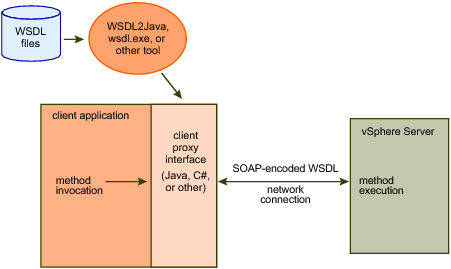|
■
|
|
■
|
For information about the WS-I Basic Profile 1.0, go to the Web Services Interoperability Organization (WS-I) Web site at http://www.ws-i.org.
The vSphere Web Services SDK provides a set of WSDL (Web Services Description Language) files that define the vSphere Web Services API. Web-services development tools such as JAX-WS wsimport, or Microsoft .NET wsdl.exe use these WSDL files to generate client-side proxy code (stubs).
Client-Server Communication Through a Client Proxy Interface is a representation of a client application that uses the client proxy interface to call a method. The client proxy interface is based on the WSDL definitions.
|
Important The vSphere Web Services SDK includes Java client-side proxy code that was generated using the JAX-WS toolkit. If the versions of Java and JAX-WS on your development platform are the same as those used to generate the proxy interface shipped in the SDK, you do not have to generate client-side proxy code from the WSDL. See the Developer’s Setup Guide for information about configuring a development environment for the vSphere Web Services SDK.
|
Your client application can use the vSphere API to communicate with vSphere servers over HTTPS (HTTP over an encrypted Secure Sockets Layer connection) at port 443. HTTPS is the default protocol. You can configure the server to support HTTP. Use HTTP access only for test or development environments, not for production. See the Developer’s Setup Guide for details.
|
■
|
Generated objects. The additional objects provide access to the vSphere Web Service to establish the client-server connection (VimServiceLocator, AppUtil) and declare the methods defined for the vSphere API (VimPortType, VimService).
|
|
■
|
Generated methods. The additional methods are accessor (getter) and mutator (setter) methods for properties. For Java, the method names are constructed by adding get and set prefixes to a property name, and changing the first character of the property name to upper case.
|
Client Proxy Definitions identifies client proxy definitions for the vSphere Web Services SDK WSDL.
|
VimServiceLocator class
|
AppUtil class
|
|
|
VimPortType class
|
VimService class
|
|
|
get and set methods defined for properties
|
||
|
Data objects in the vSphere API (see the vSphere API Reference) defined as objects in the proxy interface
|
||
The following code fragments show getter and setter method declarations for the AfterStartupTaskScheduler.minute property.
You can extrapolate the getter and setter methods that are available in the client proxy interface from the vSphere API Reference. For example, the ScsiLun data object has a displayName property. For the Java API, you can use a setDisplayName method to assign a string value to the property, and obtain the string value by using the getDisplayName method. The vSphere Web Services SDK includes Java and C# sample code that illustrates using the proxy interfaces. See Client Applications.
In this guide, the UML class and object diagrams use the primitive data type names such as string and integer, without the XML Schema definition namespace prefix (xsd:). The vSphere API Reference contains the complete data type name, such as xsd:string. The data types map to the primitive data types of the programming language used for the client application.
Standard XML Schema Primitives to Java and .NET Data Type Mappings lists some of the more common XML primitive data type mappings.
